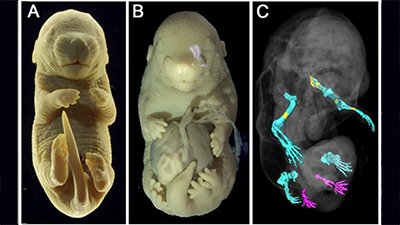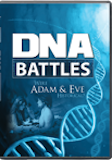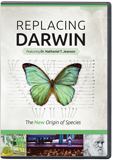The Best-Kept Secrets of DNA
Creation science is quietly making groundbreaking discoveries.
Sixty-eight years ago to the day, a group of researchers announced the solution to a long-standing scientific mystery.1 Unbeknownst to them, their discovery opened the door to a seemingly endless room of wild secrets.
The discovery of the structure of the double helix in 1953 turned everyone’s attention to DNA.
Prior to 1953, no one knew the physical basis for inheritance. Almost a century prior, Gregor Mendel had published his now-famous results from his pea-plant-crossing experiments, documenting the mathematical behavior of visible traits, like pea seed color and pea seed shape. But Mendel didn’t know the biological reasons for why his pea plants behaved the way they did. In the 100 years that followed, proteins emerged as a leading candidate for the physical basis for heredity. The discovery of the structure of the double helix in 1953 turned everyone’s attention to DNA.
Since then, it’s been hard to get our attention away from it. Astonishing findings keep calling us back.
Ethnicity and History
Today, we take for granted that our DNA encodes our traits and ethnic features. The popularity of genetic testing companies is a testament to this fact. What many do not know is the deeper—and startling—ethnic history that our DNA has revealed.
Nearly all Caucasian-Americans claim ancestry from Europe. This is true for my own family tree. However, the majority of Europeans—and the ancestors to today’s Americans—arrived in Europe from Central Asia during the Middle Ages.2 You could make the case that most Caucasian-Americans are, in a sense, Asian-Americans. They might not look Chinese, but DNA betrays the recent link.
African-Americans trace their ancestry to sub-Saharan Africa. The nasty history of the Trans-Atlantic slave trade makes this connection unavoidable. But deeper in history, in the centuries before the time of Christ, the major sub-Saharan African DNA lineage joined to what is now a North African one. Long story short, this genetic union intimates a historical link with ancient Egypt. Yes, dark-skinned African-Americans may have lighter-skinned Egyptians as their ancestors.3
Native Americans have seen their own history rewritten by DNA. Recent studies of the male-inherited DNA, the Y chromosome, indicate that today’s Native Americans were not the first Americans. Today’s indigenous Americans arrived in the Americas in the first several centuries A.D. They seem to have replaced whoever was here prior—peoples like the Maya and the Olmecs.4
These discoveries are just the tip of the iceberg. Research into human history based on DNA is just getting started, yet these results have already rewritten popular notions of who we are.
The Bigger Picture
Humans aren’t the only species to benefit from the discovery of the structure of DNA. Species around the globe—from anacondas to zebras—have had their natural histories laid bare by DNA. Thousands of species have formed within the last few thousand years, and DNA has uncovered how. We now know that the ancestors (kinds) to these species had massive speciation potential hard-coded into their DNA from the start. With such a large potential for biological change, it’s no surprise that, for example, tigers, lions, cheetahs, and housecats all arose from a common ancestor in a short period of time.5 In fact, this hard-coded genetic potential is so great that species are still forming to this day.6
DNA has relit this scientific debate.
If these discoveries weren’t enough, the impact of DNA has gone beyond the life sciences and into the physical sciences. For over 200 years, the age of the earth has been a contentious topic with outsized implications. Anyone who has engaged the debate knows that this question isn’t simply an arcane academic pursuit. It strikes at the heart of Christianity itself. DNA has relit this scientific debate.
Within the cells of humans and animals exists a genetic clock. Each generation, the reproductive cells in various species copy the DNA of the parents, but they do so imperfectly. Each DNA mistake represents another tick of the DNA clock. Species have been marking off—with their DNA—the time since their inception.
It turns out that they’ve marked off only a few thousand years of history.7 Indirectly, they’ve also pointed toward a recent origin for the earth. Both creation and evolution link the timeline of species’ origins to the timeline of earth’s origin. If species have a short history, then the earth must as well.
Creationist Discoveries
In case it’s not obvious, these revolutionary discoveries were all made within a young-earth creationist framework. Discard the possibility that God created the universe in six days 6,000 years ago, and you’ll end up asking the wrong questions and looking in the wrong places for answers. Start with the Bible, and a whole world of research questions and answers arises.
I don’t think the scientists in 1953 would have seen this situation coming: a creationist framework that advances our knowledge about the natural world? A biblical basis for uncovering the secrets hidden within DNA? Hardly anyone in the mainstream community then—or since—could have predicted this. On one hand, evolutionists shouldn’t be surprised. It’s what they have demanded of creationists for decades, both in the courtroom8 and in the classroom.9 On the other hand, I don’t think they ever expected creationists to meet their demands.
But creationists have. It’s one of the mainstream scientific community’s best-kept secrets—and it conceals so many more.
Footnotes
- James Watson and Francis Crick, “Molecular structure of nucleic acids: A structure for deoxyribose nucleic acid,” Nature 171 (1953): 737–738.
M.H.F. Wilkins, A.R. Stokes, and H.R. Wilson, “Molecular structure of deoxypentose nucleic acids,” Nature 171 (1953): 738–740.
R.E. Franklin and R.G. Gosling, “Molecular configuration in sodium thymonucleate,” Nature 171 (1953): 740–741. - Genetic foundation for claims:
Nathaniel T. Jeanson, and Ashley D. Holland, “Evidence for a Human Y Chromosome Molecular Clock: Pedigree-Based Mutation Rates Suggest a 4,500-Year History for Human Paternal Inheritance,” Answers Research Journal 12 (2019): 393–404, https://answersingenesis.org/theory-of-evolution/molecular-clock/evidence-human-y-chromosome-molecular-clock/
Nathaniel T. Jeanson,“Testing the Predictions of the Young-Earth Y Chromosome Molecular Clock: Population Growth Curves Confirm the Recent Origin of Human Y Chromosome Differences,” Answers Research Journal 12 (2019): 405–423, https://answersingenesis.org/theory-of-evolution/molecular-clock/testing-predictions-human-y-chromosome-molecular-clock/
Basis for application to history is the following forthcoming book:
Nathaniel T. Jeanson, The Hidden History of Humankind.
See also episodes 7, 8, and 10 of the following video series for early findings in this regard: https://www.youtube.com/playlist?list=PL1v9pqs4w1mwrGlCET76Rs99Fx0EfJXE4 (also available via Answers.tv). - Genetic foundation for claims:
Jeanson and Holland, “Evidence for a Human Y Chromosome Molecular Clock.”
Jeanson, “Testing the Predictions of the Young-Earth Y Chromosome Molecular Clock.”
Basis for application to history is the following forthcoming book:
Jeanson, The Hidden History of Humankind.
See also episode 19 of the following video series for early findings in this regard:
https://www.youtube.com/playlist?list=PL1v9pqs4w1mwrGlCET76Rs99Fx0EfJXE4 (also available via Answers.tv). - Nathaniel T. Jeanson, “Young-Earth Y Chromosome Clocks Confirm Known Post-Columbian Amerindian Population History and Suggest Pre-Columbian Population Replacement in the Americas,” Answers Research Journal 13 (2020): 23–33, https://answersingenesis.org/theory-of-evolution/molecular-clock/young-earth-y-chromosome-clocks/.
See also forthcoming book:
Jeanson, The Hidden History of Humankind.
See also episodes 11–14 of the following video series:
https://www.youtube.com/playlist?list=PL1v9pqs4w1mwrGlCET76Rs99Fx0EfJXE4 (also available via Answers.tv). - Nathaniel T. Jeanson and Jason Lisle, “On the Origin of Eukaryotic Species’ Genotypic and Phenotypic Diversity:
Genetic Clocks, Population Growth Curves, and Comparative Nuclear Genome Analyses Suggest Created Heterozygosity in Combination with Natural Processes as a Major Mechanism,” Answers Research Journal 9 (2016): 81–122, https://answersingenesis.org/natural-selection/speciation/on-the-origin-of-eukaryotic-species-genotypic-and-phenotypic-diversity/.
Nathaniel T. Jeanson Replacing Darwin: The New Origin of Species (Green Forest, AR: Master Books, 2017). - Nathaniel T. Jeanson, “A Bombshell for Replacing Darwin?” March 1, 2018, https://answersingenesis.org/evidence-against-evolution/bombshell-replacing-darwin/;
Nathaniel T. Jeanson, “A Second Bombshell for Replacing Darwin?” March 9, 2018, https://answersingenesis.org/evidence-against-evolution/second-bombshell-replacing-darwin/. - Nathaniel T. Jeanson, Replacing Darwin.
- McLean v. Arkansas Board of Education.
- Douglas Futuyma and Mark Kirkpatrick, Evolution (Sunderland, MA: Sinauer Associates, Inc., 2017).
Recommended Resources

Answers in Genesis is an apologetics ministry, dedicated to helping Christians defend their faith and proclaim the good news of Jesus Christ.
- Customer Service 800.778.3390
- © 2024 Answers in Genesis








